Hirohiko Araki’s JoJo’s Bizarre Adventure is known for flamboyant battles, surreal visuals, and bizarre abilities, but beneath the wild aesthetics, there’s a consistent truth in the series’ logic: a Stand reflects its user’s core self.
Within the story, Stands are often described as a manifestation of one’s fighting spirit. But beyond raw combat, they’re deeply personal symbols of how their user approaches challenges, applies their skills, and navigates their unique struggles.
In other words, a Stand is less about looking cool and more about expressing a philosophy of problem-solving turned into a superpower. From Part 3 onward, each JoJo protagonist’s Stand is carefully crafted to be an idealized mirror of their personal growth, values, and story themes.
Guide to hidden symbolism behind every main JoJo stand in JoJo’s Bizarre Adventure
JoJo’s Bizarre Adventure: Stardust Crusaders – Jotaro Kujo and Star Platinum
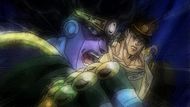
Jotaro in JoJo’s Bizarre Adventure was the first main character to wield a Stand, so Star Platinum had to carry a double burden; it needed to symbolize his personality while also acting as the archetype for the entire power system.
On the surface, Jotaro is intimidating, even violent. But beneath that tough exterior is an incredibly cautious thinker who calculates every consequence before acting. He’s not reckless; he’s decisive.
He knows that problems aren’t solved by hesitation. Whether the solution is persuasion, intimidation, or direct action, the goal is always to make a tangible change in the situation.
Star Platinum embodies this philosophy perfectly:
- It’s overwhelmingly strong at close range, representing Jotaro’s commitment to precision and control over his actions.
- Its limited range is symbolic; he focuses deeply rather than spreading himself thin.
- The iconic time stop is less about omnipotence and more about creating windows of opportunity, a way to act while the rest of the world stands still.
Even early in the story, when Jotaro doesn’t fully understand his Stand, he’s willing to take drastic steps, like imprisoning himself, to keep others safe.
And once he does understand Star Platinum, he constantly uses it as an extension of his strategic thinking, never just as a blunt weapon. Jotaro’s Stand is about hitting hard, hitting smart, and hitting at the right moment.
JoJo’s Bizarre Adventure: Diamond is Unbreakable – Josuke Higashikata and Crazy Diamond
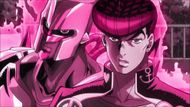
Josuke inherits Jotaro’s mix of aggression and cunning, but his emotional triggers are different. His biggest flaw is losing control in bursts of anger, especially when someone mocks his hair.
This volatility is baked into the design of Crazy Diamond: a Stand that channels Josuke’s aggression into healing rather than destruction. Crazy Diamond can repair broken objects and heal injuries by restoring their original form. But this ability has strict boundaries:
- It cannot undo death.
- It can only work with the physical building blocks present. If something essential is missing, Josuke must improvise a replacement.
- The restored object might not be exactly as it was, allowing for creative reinterpretation.
Symbolically, Josuke’s power reflects the idea that while we can try to fix what we’ve broken, some lines, especially death, cannot be crossed. His Stand is about moving forward with what’s left, making the best of the present rather than clinging to an unchangeable past.
Where Jotaro in JoJo’s Bizarre Adventure focuses on preventing damage, Josuke accepts that damage is inevitable but believes in mending what you can. It’s a philosophy rooted in compassion and also in realism.
JoJo’s Bizarre Adventure: Golden Wind – Giorno Giovanna and Gold Experience
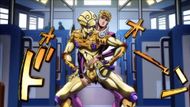
Giorno’s Stand is deceptively gentle in concept: giving life to inanimate objects. But its symbolic meaning is layered deeply into his personal arc.
As Dio’s son with Jonathan’s moral compass, Giorno seeks to revitalize a decaying society from within the very criminal structure that rots it. Gold Experience doesn’t control the life it creates, just as Giorno seeks to lead people by inspiring loyalty rather than imposing domination.
Key symbolic traits:
- Life Creation: Giorno turns lifeless objects into animals or plants, reflecting his mission to renew and protect life.
- Damage Reflection: Creatures he powers can return damage to their attackers, symbolizing Giorno’s role as a protector of what he fosters.
- Growth Acceleration: He can push life to develop faster, mirroring his desire to create rapid change in a stagnant environment.
Importantly, Gold Experience in JoJo’s Bizarre Adventure can’t bring back the dead, but it can repurpose what remains. This distinction underscores one of the series’ unspoken rules: true resurrection is impossible because the past is immutable.
Even when Giorno gives Bruno Bucciarati a “second wind,” it’s by altering his body to anchor his lingering soul, not reversing death itself.
JoJo’s Bizarre Adventure: Stone Ocean – Jolyne Cujoh and Stone Free
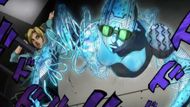
Jolyne starts her journey trapped physically, socially, and by the legacy of Dio’s vendetta against her family. Her Stand, Stone Free, allows her to unravel her body into thread, symbolizing her willingness to sacrifice comfort, safety, and even her own physical integrity to gain control over her life.
Where Jotaro used precision and Giorno used revitalization, Jolyne uses adaptability:
- Thread can bind, weave, entangle, or spy, mirroring her resourcefulness.
- Unraveling herself shows her readiness to break down her identity, endure pain, and reassemble stronger.
- The fragility of thread reflects the high personal cost of her struggle. Freedom is earned, not given.
Jolyne’s power emerges from the remnants of a destroyed Stand Arrow, a metaphor for her starting with far less than other JoJo protagonists. Yet, she turns that limitation into strength, proving that even sabotage and disadvantage can be spun into victory with enough resolve.
JoJo’s Bizarre Adventure: Steel Ball Run – Johnny Joestar and Tusk
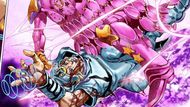
Johnny begins his story in JoJo’s Bizarre Adventure: Steel Ball Run physically crippled, emotionally broken, and spiritually aimless. Unlike other JoJos, he doesn’t start with the mental or emotional readiness to wield a Stand. Instead, he grows into it, step by step, mirrored perfectly in Tusk’s “Act” evolution.
Each Act reflects a stage in Johnny’s personal development:
- Act 1: Reliance on miracles. Johnny gains the Stand through the Saint’s Corpse, not his own capability. His power is limited and unfocused.
- Act 2: Learning self-reliance. Johnny develops techniques (nail bullets) by adapting to his environment instead of depending on others.
- Act 3: Embracing persistence. He understands that value lies in using what you have, not hoarding it for a “perfect” moment.
- Act 4: Mastery. Johnny no longer waits for the universe to hand him victory. He actively reshapes his environment to suit his goals.
The segmented nature of Tusk is symbolic: true independence isn’t gained in a single leap; it’s built in acts, with setbacks and revelations along the way.
JoJo’s Bizarre Adventure: JoJolion – Josuke Higashikata and Soft & Wet
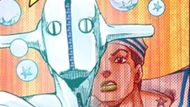
This Josuke (a fusion of two people) begins without memories, free from the chains of the past that bind others in Morioh. His Stand, Soft & Wet, steals qualities from objects or people and stores them in bubbles.
Symbolically, this power represents the gaps in cause and effect, opportunities to rewrite outcomes by removing a single link in the chain.
- Bubbles as Fragile Agents: Each bubble is delicate alone, but together they’re versatile and powerful, like Josuke’s own improvised identity.
- Extraction Ability: By removing a property (e.g., friction from the ground), Josuke disrupts situations in ways that brute force never could.
- Heritage Acceptance: His Stand reaches its full potential when he embraces who he is now, not who he was before the fusion.
Josuke’s story in JoJo’s Bizarre Adventure is about learning that where you belong is more important than where you came from. His Stand’s ability to take away and rearrange mirrors his eventual understanding that the past doesn’t define his present; it’s the connections he makes now that matter.
